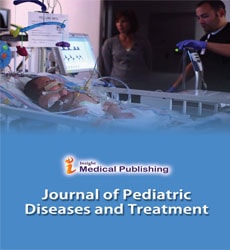A Case Report of Tetralogy of Fallot in an Infant without a Cardiac Murmur at Presentation
Brett Hansen and Mary Emborsky
Brett Hansen1* and Mary Emborsky2
1Department of Emergency Medicine, University at Buffalo, Buffalo, New York, USA
2Pediatric Emergency Medicine, University at Buffalo, Buffalo, New York, USA
- *Corresponding Author:
- Brett Hansen, MD, MPH
Emergency Medicine Resident
University at Buffalo
77 Goodell Street, Suite 340, Buffalo, New York, USA
Tel: +17166459707
E-mail: Bretthan@buffalo.edu
Received Date: April 12, 2019; Accepted Date: April 23, 2019; Published Date: May 02, 2019
Citation: Hansen B, Emborsky M (2019) A Case Report of Tetralogy of Fallot in an Infant without a Cardiac Murmur at Presentation. Pediatr Emerg Care Med Vol.4 No.1:1.
Copyright: © 2019 Hansen B, et al. This is an open-access article distributed under the terms of the Creative Commons Attribution License, which permits unrestricted use, distribution, and reproduction in any medium, provided the original author and source are credited.
Abstract
Introduction: The purpose of this case presentation is to convey the importance of considering congenital heart abnormalities in previously healthy pediatric patients who present in a hypoxic, unresponsive state in the absence of cardiac murmur.
Case presentation: An 11-month old male who was previously healthy presenting with an episode of sudden unresponsiveness and respiratory failure of unknown etiology. The patient was transferred from an outside facility to a pediatric emergency department (ED) in respiratory failure with altered metal status.
Management and outcome: Following initial stabilization the patient remained hypotensive. In the ED a bedside cardiac ultrasound demonstrated poor left ventricular contraction. Traumatic and Neurosurgical emergencies were ruled out in the ED and the patient was admitted to the pediatric intensive care unit (PICU) for presumed cardiopulmonary failure. In the PICU the patient remained hypotensive and Extracorporeal Membrane Oxygenation (ECMO) was initiated. A formal cardiac ultrasound was obtained which demonstrated findings consistent with Tetralogy of Fallot. The patient was transferred to an outside facility for pediatric cardiothoracic surgery evaluation. His abnormality was ultimately repaired.
Discussion: The majority of congenital heart disease is diagnosed near the time of birth but may present suddenly in otherwise well pediatric patients. Clinical suspicion for congenital heart disease should be in the differential diagnosis of an unresponsive pediatric patient without cardiac murmur. We review the presentation and clinical findings in patients with Tetralogy of Fallot.
Keywords
Tetralogy of Fallot; Congenital heart disease; Cyanotic heart disease; Type one respiratory failure
Introduction
Tetralogy of Fallot (TOF) is a cyanotic congenital heart disease that is variable in presentation, and is composed of four anatomic abnormalities including; stenosis of the pulmonary artery, intraventricular communication, deviation of the origin of the aorta to the right and concentric right ventricular hypertrophy [1]. The prevalence of TOF is approximately 1 in 3600 lives births and accounts for 3.5% of infants born with congenital heart disease [2]. The timing of symptomatic presentation is largely based on the degree of right ventricular outflow obstruction [3]. The pathophysiology of TOF results from the shunting of desaturated, systemic venous blood via the ventricular septal defect with the systemic blood of the cardiac output. The degree of the shunt is based on the degree of obstruction of pulmonary outflow. The greater the resistance to outflow of the right ventricle the greater the degree of the right to left shunt leading to more prevalent desaturation. TOF cases are important to identify because of the excellent prognosis after repair. The 20-year survival rate following operative intervention is approximately 98% [2]. Prior to the advent of surgical repair half of the patients with TOF died during the first years of life [1]. The purpose of this case report is to review a late presentation of TOF in a previously healthy 11-month old with no significant past medical history.
Case Presentation
A 11 month-old-male with no significant past medical history and in his usual state of health presented to a community ED after a sudden event of unresponsiveness. Reportedly, the patient was eating when he threw his head back and became unresponsive. On the arrival of emergency medical services (EMS) the patient had a respiratory rate of four and bag valve mask ventilation was initiated for apnea. The patient was transported to the nearest community hospital. On arrival, the patient was bradycardic and hypotensive, with a rectal temperature of 35.1°C. His point of care blood glucose was 113. He was given one dose of atropine and Narcan, then endotracheal intubated for respiratory failure. Imaging obtained including a CT scan of the head which was negative for any acute pathology and a chest X-ray without other acute findings.
The patient’s lab work was significant for a venous blood gas with a pH of 6.95. He was simultaneously given two normal saline boluses of 20 ml/kg. The pediatric transport team was dispatched. On arrival, the patient’s heart rate was 187, blood pressure was 120/72, oxygen saturation was 100% while being bagged through the ET tube. A venous blood gas at this time demonstrated a pH of 6.65, pCO2 of 56 mmHg, pO2 of 77 mmHg, HCO3 of 6.3 mmol/L, Calcium of 5.4 mg/dL, Glucose of 282 mg/dL and a Hgb of 14.3 g/dL.
The transport team noted seizure-like activity and administered Midazolam and Phenobarbital. Additionally, he was given sodium bicarbonate for his acidosis. While in route to Children’s Hospital the patient’s end tidal CO2 began to drop from 57 to 18 with desaturations to 83%. The patient became hypotensive with a blood pressure of 52/31. In response, an epinephrine drip was initiated along with a repeat dose of sodium bicarbonate.
Management and Outcome
The patient arrived at pediatric ED under a Level 1 trauma activation, given the possibility of non-accidental trauma. The ED staff, trauma surgery, neurosurgery and pediatric intensivists teams were present at the patient’s arrival. Vital signs on arrival were; a temperature of 35°C, blood pressure of 72/42, heart rate of 151, and an oxygen saturation of 79% on 100% FiO2. The patient’s physical exam was notable for tachycardia, equal breath sounds bilaterally, pupils mildly sluggish 4 mm bilaterally. The remaining physical exam findings were unremarkable and without evidence of trauma, or cyanosis.
A point of care ultrasound was performed which showed poor left ventricular contraction, but otherwise negative FAST examination. The Patient was subsequently admitted to the Pediatric Intensive Care Unit (PICU) for presumed cardiopulmonary failure.
The patient was initially placed on an Oscillator in the PICU, however, the oxygen saturations remained low and the patient remained hypotensive. An echocardiogram performed demonstrated severe right ventricular hypertrophy, reduced left ventricular contractility and overriding aorta. The right ventricular outflow tract and pulmonary valve were not completely visualized. These findings were concerning for possible TOF. The patient was then placed on veno-arterial ECMO. A Repeat echocardiogram was obtained following successful ECMO cannulation re-demonstrating the previous findings as well as a hypoplastic pulmonary valve and pulmonary artery consistent with TOF. Once the patient was on ECMO his hemodynamics improved and he was successfully weaned off vasopressors. Once stabilized the patient was transferred to a facility with pediatric cardiothoracic surgery services. He ultimately underwent surgical repair of the TOF abnormality.
Discussion
TOF is a congenital cyanotic heart disease that presents with a right-to-left cardiovascular shunt. The timing of symptomatic presentation is largely based on the degree of right ventricular outflow obstruction. When right ventricular outflow is severe it results in a large right-to-left ventricular shunt with poor pulmonary blood flow. Patients are usually diagnosed shortly after birth, usually before leaving the hospital. When not diagnosed at birth infants present with hypoxemic or “Tet spells” which consist of cyanosis, hypoxia, dyspnea, agitation, and alterations in conscious. These symptoms frequently start to present around 4-6 months of age and are associated most often with crying or feeding [4].
Several findings in this patient’s presentation are worth further discussion. Interestingly, there was no known prior history of hypoxemic spells, and his presentation is consistent with a sudden severe decompensation. The patient’s hemoglobin and hematocrit were not elevated which would be expected if his hypoxia were chronic.
Several physical exam findings are also worth discussing. The patient was not cyanotic on physical exam, but was significantly hypoxic. This may have been because he had darker skin, which can make detecting cyanosis more challenging [5]. A murmur was not auscultated at the initial community hospital or in the pediatric ED. This is possible because the nature of the murmur, which is caused by both the degree of obstruction and the amount of flow across the obstruction. The classic TOF murmur is a harsh loud systolic murmur, which occurs secondary to right-sided heart outflow. The VSD does not generate a murmur as it is unrestrictive, since, the pressures of the right and left ventricles are equal [6]. When severe obstruction is present, the flow across the valve significantly decreases, and may soften the murmur or make it disappear [6].
The initial presentation of TOF can be sudden and severe. It should be considered in any unresponsive pediatric patients who present with hypoxia and cyanosis. It is especially important to consider congenital heart disease without the presence of a murmur. This finding may not be well known in the general emergency medicine community, as it isn’t commonly discussed in emergency medicine texts [7].
Disclaimer
Nothing to disclose.
Sources of Financial Support
None.
References
- Apitz C, Webb GD, Redington AN (2009) Tetralogy of fallot, The Lancet 374: 1462-1471.
- Shinebourne, Elliot A, Carvalhoe J (2005) Tetralogy of Fallot: from Fetus to Adult. Heart 92: 1353–1359.
- Jone P (2018) Cardiovascular Diseases. Current Diagnosis & Treatment: Pediatrics. 24th edn. New York NY McGraw-Hill.
- Kellerman RD, Bope ET, Conn HF (2018) Conns current therapy 2018. Philadelphia, PA, PA: Elsevier.
- Sasidharan P (2004) An approach to diagnosis and management of cyanosis and tachypnea in term infants. Pediatric Clinics of North America 51: 999-1021.
- Pelech AN. Murmurs. In Nelson Pediatric Symptom-Based Diagnosis(pp. 116-143). Philadelphia, PA: Elsevier.
- Tintinalli JE and Stapczynski JS (2016) Tintinallis emergency medicine: A comprehensive study guide. New York: McGraw-Hill.

Open Access Journals
- Aquaculture & Veterinary Science
- Chemistry & Chemical Sciences
- Clinical Sciences
- Engineering
- General Science
- Genetics & Molecular Biology
- Health Care & Nursing
- Immunology & Microbiology
- Materials Science
- Mathematics & Physics
- Medical Sciences
- Neurology & Psychiatry
- Oncology & Cancer Science
- Pharmaceutical Sciences
